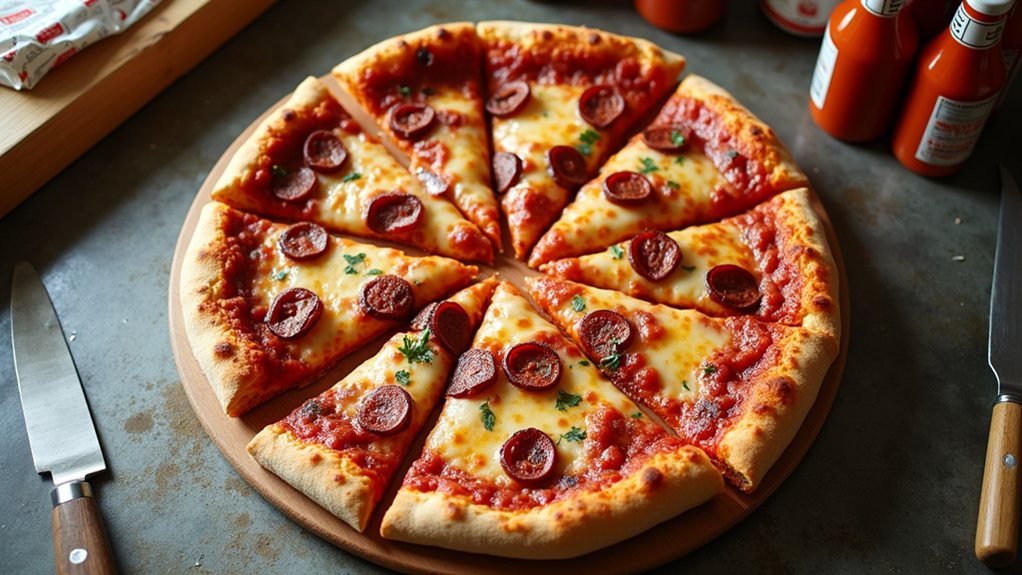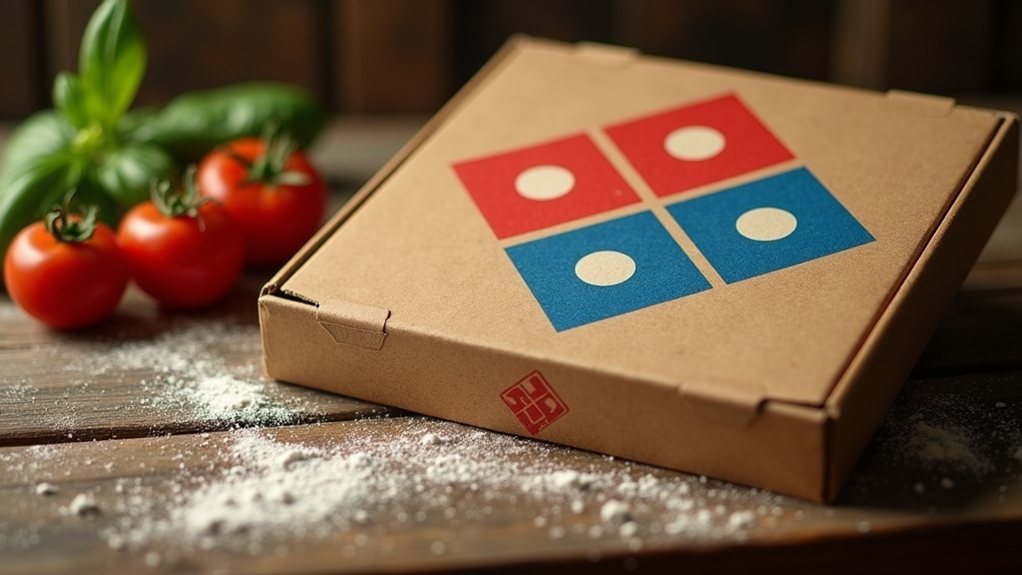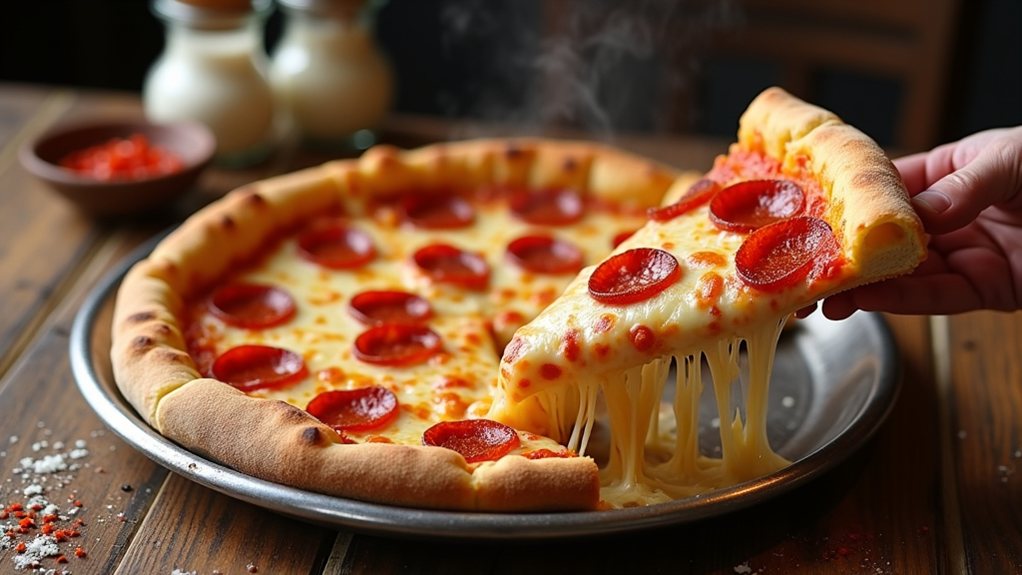Chicago’s lesser-known pizza style often gets overlooked in the shadow of its deep-dish cousin. The thin crust variety, however, offers a distinctly satisfying crunch that many locals prefer. Its cracker-like base, edge-to-edge toppings, and unique square-cut presentation set it apart from New York-style pies. Mastering this regional specialty at home requires understanding a few key principles that transform ordinary ingredients into an authentic Windy City experience. The adventure begins with the foundation: a properly formulated dough.
The History and Character of Chicago’s Lesser-Known Pizza Style

While Chicago is internationally famous for its deep-dish pizza, the city’s thin crust has quietly maintained a devoted local following for nearly a century.
Born during the Prohibition era of the 1920s, this distinctive style features a cracker-thin base that offers a satisfying crunch with every bite.
Unlike its New York counterpart, ChChicago’shin crust extends toppings to the very edge and is traditionally cut into small squares rather than triangular slices, making it perfect for sharing.
This tavern-style pizza requires no special equipment, allowing home cooks to recreate authentic Chicago flavor with standard kitchen tools.
Despite being less renowned than the thick, buttery crust pizza that contributed significantly to Chicago’s culinary identity, thin crust remains an important part of the city’s pizza heritage.
Crafting the Perfect Cracker-Thin Dough
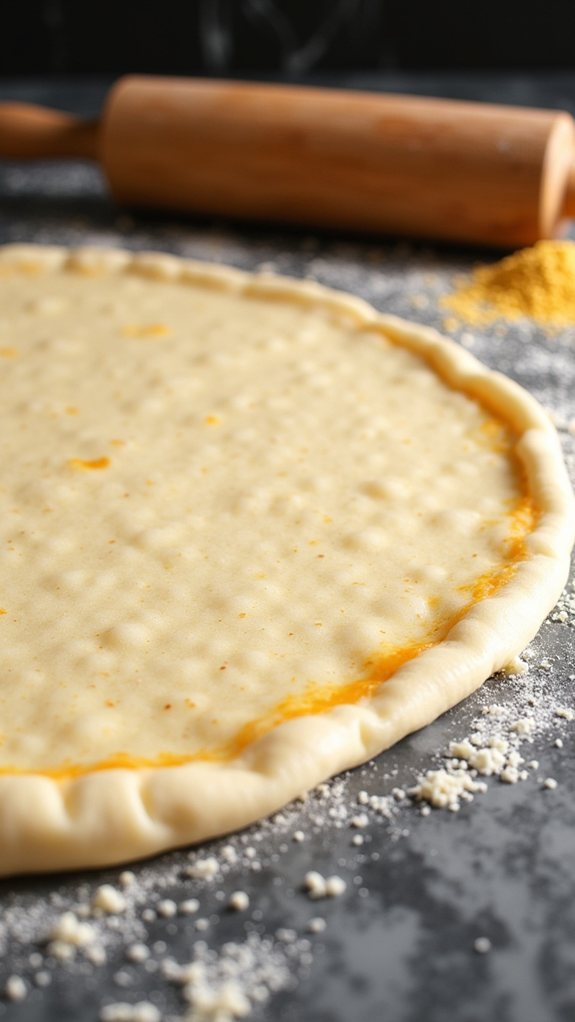
The foundation of exceptional Chicago thin-crust pizza lies in its distinctive dough, which more closely resembles a sturdy cracker than the chewy, elastic base found in other pizza styles.
This unique texture comes from a drier, oilier mixture of flour, salt, yeast, sugar, water, and olive oil combined in careful proportions.
Unlike traditional pizza dough, Chicago thin crust aims for minimal gluten development. The oil coats protein molecules, limiting their ability to form elastic networks.
After mixing, the dough needs at least three hours to rest, though overnight fermentation delivers superior flavor. The transformation completes during baking when the thin-rolled dough crisps into its signature cracker-like consistency.
Using a rolling pin helps achieve the consistent thinness essential for authentic Chicago-style thin thin-crusta.
The Science Behind Minimal Gluten Development
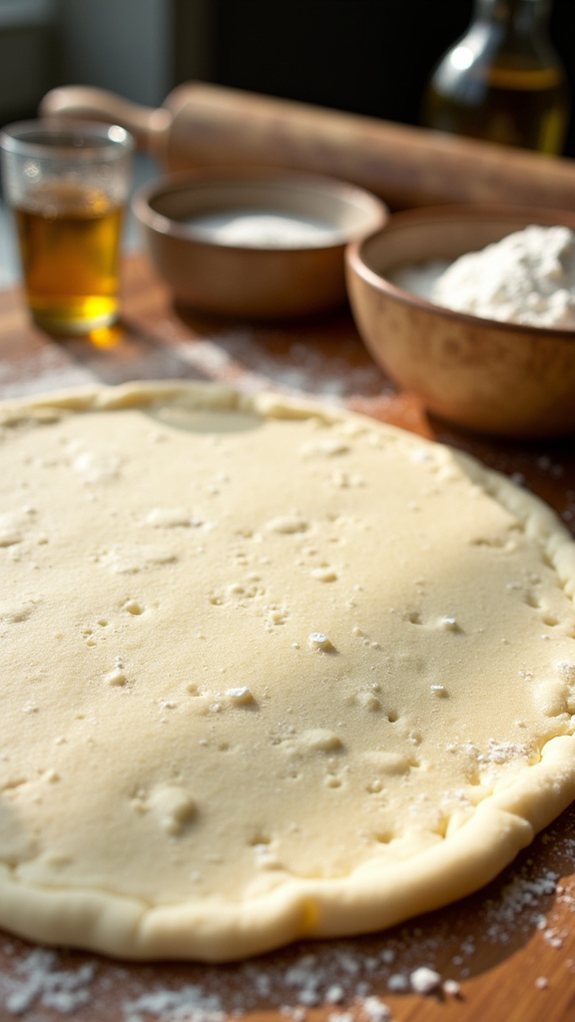
Creating the signature texture of Chicago thin-crust involves a fascinating balancing act with gluten, the protein compound that gives most bread its chewy elasticity.
Unlike traditional pizza doughs, ChicagChicago’scrust deliberately limits gluten development to achieve its distinctive cracker-like bite.
The oil in the dough plays an essential role in coating flour proteins and preventing them from forming strong gluten networks. This explains why the mixing time is shorter, typically just five minutes in a stand mixer.
The extended resting period, ideally overnight, allows what little gluten has formed to relax completely, ensuring the crust shatters rather than stretches when bitten.
For deep-dish Chicago-style pizzas, using high-gluten flour creates the sturdy foundation needed to support the weight of layers of cheese, toppings, and sauce.
Dough Resting and Curing Techniques for Maximum Crispness
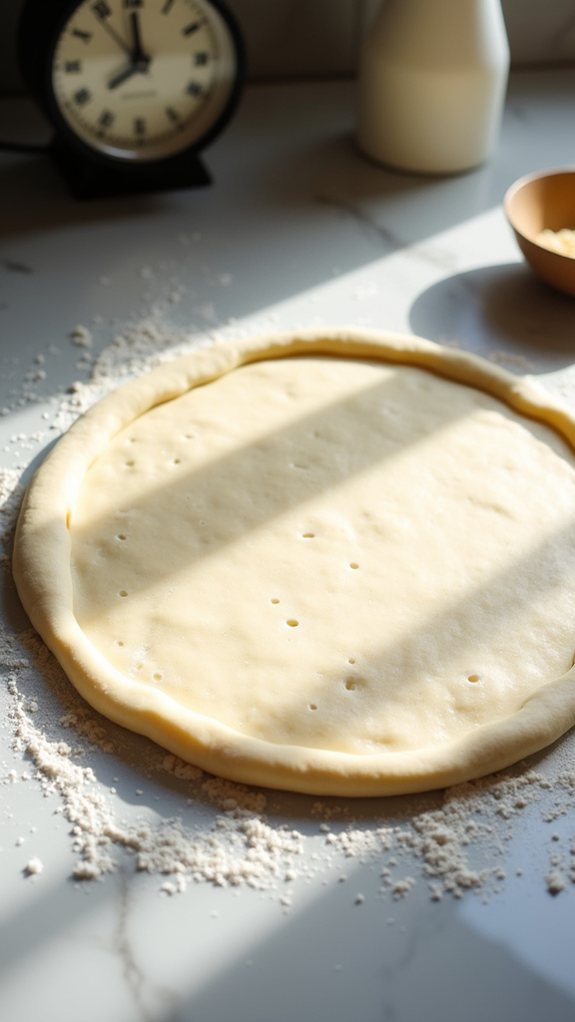
Achieving maximum crispness in Chicago’s thin curtain crust requires strategic dough resting and curing techniques that fundamentally transform its texture. The process builds flavor while creating that signature cracker-like base.
- Rest the dough for at least 3 hours, preferably overnight.
- Refrigerate for 1-5 days to develop complex flavors.
- Roll to 14-inch a circle before uncovered overnight curing.
- Reduce hydration from 50% to 30-35% during the curing phase.
This patient approach allows water to evaporate naturally, yielding that distinctive dry crunch that separates Chicago Chicago’sust from its floppy New York cousin.
Rolling and Shaping Your Chicago-Style Base
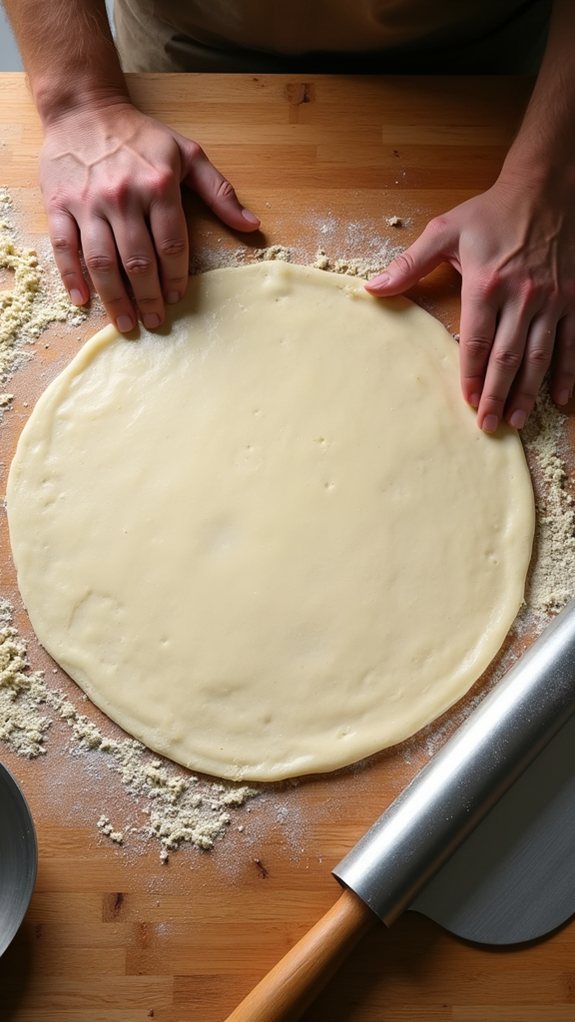
Once your dough has properly rested and cured, proper rolling technique is the next step in your Chicago thin-crust expedition.
On a heavily floured surface, preferably with semolina mixed in, roll the dough into a perfect 14-inch circle using a tapered rolling pin for better thickness control.
Rotate the dough frequently as you roll to maintain an even shape and prevent sticking. If the dough resists and pulls back, give it a brief rest to relax the gluten.
The goal is cracker-thin consistency from edge to edge – far thinner than you might initially think necessary for a proper Chicago-style base.
Creating Authentic Chicago Thin Crust Toppings

The toppings are a crucial element in authentic Chicago thin-crust pizza, distinguishing this regional specialty from its coastal counterparts.
Traditional Chicago toppings are applied generously from edge to edge, creating a satisfying balance of flavors that complement the cracker-thin base.
Key elements of authentic Chicago thin-crust toppings include:
- Heavily seasoned sauce spread to the edges to prevent crust burning
- 8-12 ounces of mozzarella, with optional Romano or Parmesan cheese
- Raw Italian sausage applied in small nubs for even cooking
- Spicy giardiniera for heat, with mild options available for less adventurous palates
Square-Cut Tradition: Baking and Serving Your Masterpiece
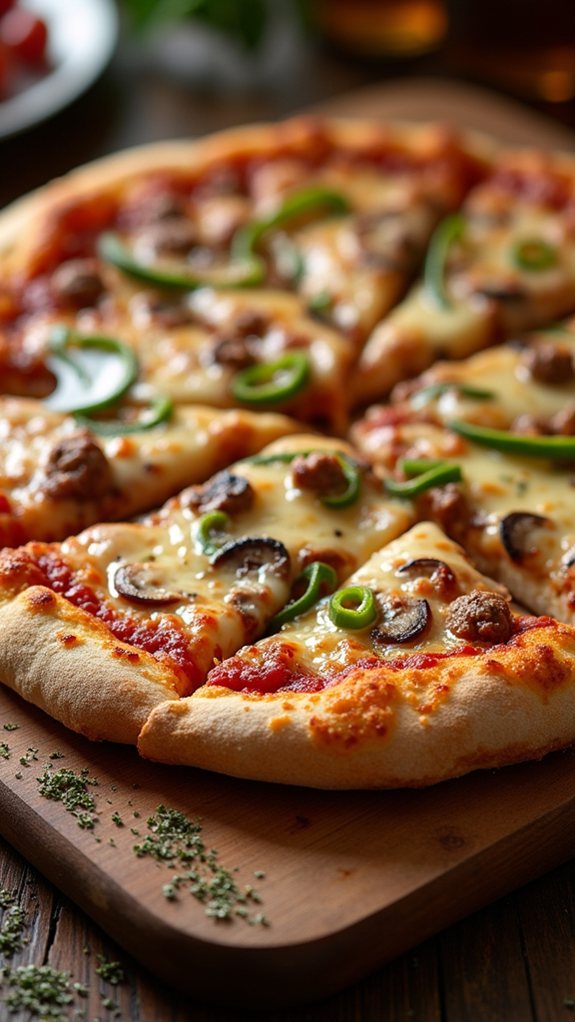
The final step in creating authentic Chicago thin-crust pizza is the distinctive square-cut tradition, which transforms the baking and serving process into a true celebration of Midwestern pizza culture.
After baking for 10-12 minutes at 500 degrees, look for those telltale brown, bubbly edges that signal your masterpiece is ready.
Let the pizza rest for about three minutes, allowing the crust to crisp up perfectly while cooling slightly.
Then, cut the pizza into small squares—typically six strips both ways—creating those coveted corner pieces with extra crunch.
This serving style, unlike the triangular New York slices, encourages sharing and sampling different sections of your thin, crispy creation.
FAQs
Can I Substitute Whole Wheat Flour in Chicago Thin Crust Dough?
Whole wheat flour can be substituted, though it will alter the traditional cracker-like texture. A blend of whole wheat and all-purpose flour offers better results while maintaining some nutritional benefits.
How Can I Prevent My Chicago Thin Crust From Getting Soggy?
Preventing a soggy Chicago thin crust requires docking the dough, applying a thin layer of sauce, using pre-cured dough, and baking on a hot stone or steel until the edges are crisp brown.
What’s the Best Cheese Blend for Authentic Chicago Thin Crust Flavor?
For authentic Chicago thin-crust flavor, primarily whole milk mozzarella should be used, with optional additions of Romano or Parmesan cheese. This combination creates distinctive crispy cheese bits along the edges.
Can Chicago Thin Crust Be Frozen Before or After Baking?
Chicago thin crust can be frozen both before and after baking. Unbaked dough freezes well for up to 3 months, while baked pizzas can be frozen for quick reheating when one desires convenient meals.
Why Is My Crust Too Brittle and Breaking During Cutting?
A brittle, breaking crust likely results from excessive drying during curing, over-baking, or too much flour during rolling. Proper hydration and baking time prevent this cracker-like fragility.

